Sometimes, your passion lets you forget all miseries and what matters is the work you love to do. As everyone across the country gears up to celebrate Ganesha Chaturthi on Sept. 2, their creators struggle to even meet their meagre daily expenses. And they pray for a better life, each day…
By Team SOM
The nature of Gods made and sold vary all through the year. Unsurprisingly, much like many remember God at the time of need, most seek to buy idols only during festive season.
As heavy rains and thunderstorms of South West Monsoon and Ashada month subside in India, particularly in the Southern part of the land, there arrives the season of festivities which begin with Shravana and Bhadrapada and continues till Sankranti.
Agriculture, which plays a vital role in our Nation, is the largest source of livelihood. Naturally, Hindu tradition and Vedic Heritage — in tune with nature — have given reverence to soil, water and air and all that are associated with them.
Many names, many forms of Ganesha
One of the important festivals of the season is Ganesha Habba or Ganesha Chaturthi or Vinayaka Chowthi. There are many names associated with the elephant-headed God, there are many forms, shapes and sizes of Ganesha and at the same time there are many ways to please Him.
A striking characteristic of Ganesha is that he is loved by one and all and in India, we find many idol-makers and decorators irrespective of caste, religion and creed. He unites India’s diversity and his festival is celebrated in every nook and corner. He is the Vighna Nivaraka and has Omnipresent, Omnipotent and Omniscient presence all over and he has to be prayed first in any auspicious occasion.
If Mumbai and Maharashtra is still famous for Sarvajanik Ganesha Mandals introduced by Bal Gangadhar Tilak in the pre-independent India, celebrations down South and up North also carries the same weight. Of course, the scale of celebrations differ — if it is a public festival in Maharashtra and Goa through Sarvajanik Ganesha Pandals, in the South it is a mix of public and private celebrations.
Ganapati or elephant head’s ears are reminiscent of dustpan (Mora in Kannada) while he loves Durva grass (Garike in Kannada). Ganesha, who symbolises authority, endurance, strength and courage is one among the multitude of symbols which the general populace ultimately reconcile as One God, Multiple Manifestations.
Of late, eco-friendly aspects associated with our festivities have been highlighted and practiced. Even the law enforcement agencies like the District Administration and the Police insist on eco-friendly Ganesha.
Following the Kumbara Gundaiah tradition
A resident of Kumbarageri or pottery town of K.T. Street (Kalamma Temple Street), 65-year-old Venkatamma, who is making Ganesha idols from generations, paying reverence to her ancestor Kumbara Gundaiah, informed SOM that her family considers Kulala Gunda Brahma as her ‘Kula Devatha’ or family deity. “Out of five sisters, only I got education and passed SSLC in those days. I got married to Ashwath in 1972 and since then have been involved in this profession. My husband is no more,” she says.
Hailing from a humble background and born to Venkata Shetty and Siddhamma, Venkatamma recalls, “During those days, we used to make four sets of clay dolls which included Rama, Lakshmana, Anjaneya and Sita Devi. The four sets altogether comprised over 60 to 70 idols and each set used to cost Rs. 2.50 in 1972. It was very popular those days and many foreigners used to purchase and carry them to their homeland in boxes. Even Mysore royal family patronised clay idols. Nowadays, we are making mainly idols of Lord Ganesha.”
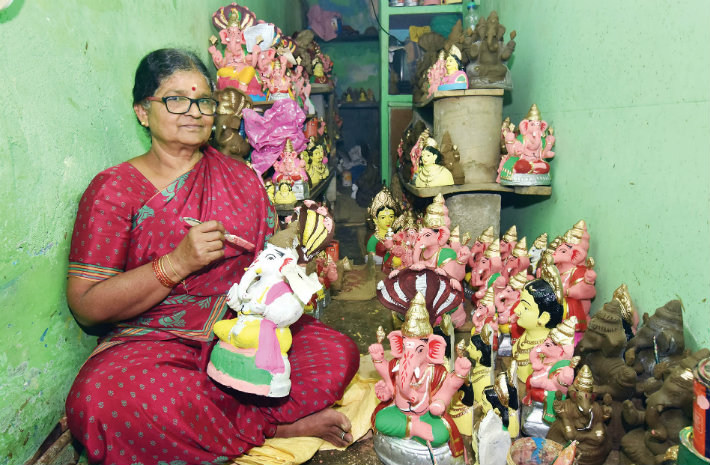
“It is not an easy job as it involves more than five months of work. Months before the festival, we get clay from far off places including KRS, Doora and Udbur villages which costs us Rs. 4,000 per tractor load. We need to hire a workman to work on wet clay in order to temper the mud and clean it out which costs Rs. 3,000. After spending Rs. 7,000 to gather and prepare the basic raw material, we start carving out the idol initially with mould and later work on adding intricacies which involves a lot of skill and imagination plus hard work. Finally, after drying them out under shade, we use natural colours to paint them,” she adds.
“I have been making idols from the last 50 years but in recent years, PoP idols are invading the market and destroying our livelihood. As they are cheap compared to clay and light in weight for transportation, now people are more attracted towards PoP idols,” she regrets.
Living a modest life in a small house, which includes a 4x11ft room exclusively for preparation and storage of idols, she says, “This profession has not made us rich, but as I don’t have any other skills for our livelihood, I am just continuing with this Kula Kasubu (family profession) and will continue this way till my last breath. And I know Ganesha will take care of me and my family.”
Earlier, there were nearly 80 to 90 artisan families in Kumbarageri. Today, one may hardly find about 10 to 15 families engaged in making Ganesha idols.Besides, the advent of PoP idols which are rich in colour and light-weight, have made it difficult for clay artisans. Though the Mysuru City Corporation (MCC) claims to have banned the PoP idols, it is only on paper as the idols continue to be sold.
Mysuru was once famous for its unique Ganapati idols
Making of Ganapati or Ganesha idols has been a family profession of 78-year-old Premamma, a resident of Vinayakanagar (Paduvarahalli). Her son Raghavendra and his whole family are helping her. 38-year-old Raghavendra, who earlier was a resident of Kumbarageri, says, “My mother is a major helping hand with her 60 years of hands-on experience. Idol-making is a tedious process which begins five months before the festival. We procure two tractor loads of clay from Hale Unduvadi and villages around Krishna Raja Sagar (KRS) Dam and make idols from 6 inch to 4 feet which would cost from as low as Rs. 60 to as high as Rs. 4,500.”
“From the days of the Maharajas, Mysuru is known for its traditional Ganesha idols. In my childhood days, people from surrounding districts including Hassan and Mandya used to visit Mysuru during festival season to purchase unique Mysuru- style idols,” says Premamma.
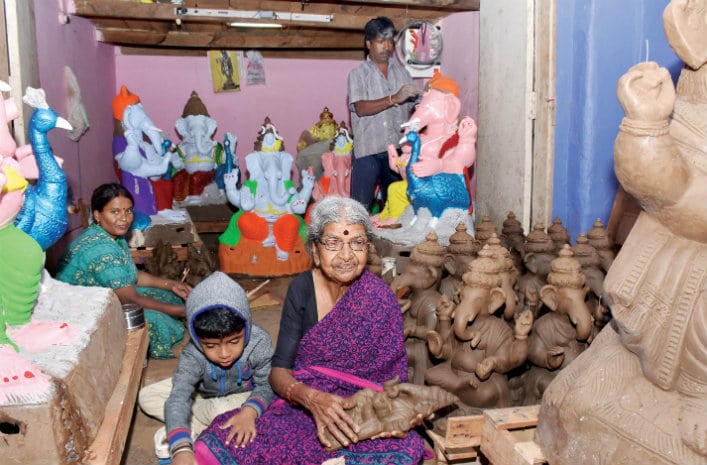
Here too, the idol-makers mention how they are facing PoP idol menace and how it is ruining their lives and also atmosphere. “Every year, PoP ban comes to limelight only during Ganesha fest. In spite of that, still they are available openly. The PoP idols must be banned throughout the year,” Premamma says.
Rain, transportation and breaking of idols are the risks clay idol-makers have to bear apart from competition from PoP idols.
Venkata Dasappa’s family vocation
The story of M.V. Kumar, a 47-year-old resident of Paduvarahalli and his family, who have honed the craft of idol-making to perfection from generations, is not different.
“I learned this art from my grandfather Venkata Dasappa and my father Venkata Ramappa. From sourcing clay from faraway places to preparation and manufacturing, it costs us a lot of money and hard work. After all this hard work, most of the time we end up selling only 250 to 300 out of 400 idols we make. It is not a huge profit-making business, but what else we can do other than this profession at this age?” asks Kumar.
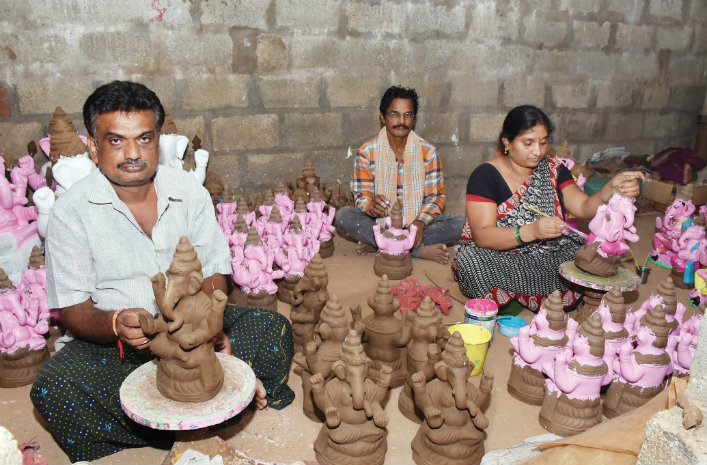
“My whole family including my mother Mangamma, wife Sujatha, mother-in-law Sundaramma and father-in-law Subramanya lend their helping hands before and during the festive season in preparation, decorating and painting the idols,” he adds.
“Mixing the clay with water to a particular temper (hada in Kannada) is the most important part of the trade. Cleaning and tempering the raw material that is clay is a time-consuming job. After preparing the basic shape with mould, we decorate each and every idol by adding ornaments like Kirita (crown) and craft-out four hands of Ganesha holding noose, hook, broken tusk and delicacy like modaka. Finally, these have to be dried under shade which carries the risk of cracking and breaking if mishandled. After all these efforts, there is always a risk of loss through rain, during transportation and breakages,” he narrates.
“In recent times, PoP idols are invading the market. As they are lightweight and cheap, I feel we are losing out. Out of 300 to 400 idols we make, most of the time we end up selling 75 percent and remaining idols we have to preserve for the next year,” he adds.
‘PoP threatening our community’
The 70-year-old Ningamma, another artisan of fifth generation from 5th Cross, Kumbarageri, shares her woes. She procures clay from villages around KRS Dam and crafts the idols with help from her family, including small children.
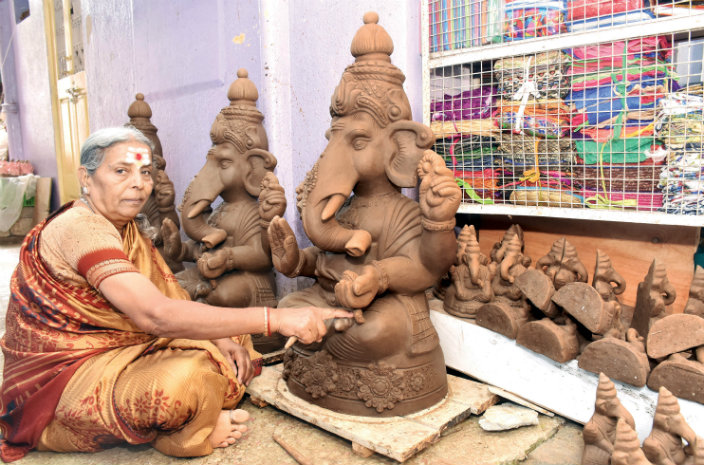
“To prepare each of a 3ft idol which would cost Rs. 2,500 to Rs. 3,500, it would take three days for preparation and decoration with our bare hands. Even after such hardship, it is just enough to manage our daily lives. I urge the Government to ban PoP idols which are snatching our livelihood,” she says with a sigh.
Menace of PoP Ganesha
As Mother Earth is grappling with rampant usage of plastic and petroleum-based products, Plaster of Paris (PoP) is one such material that has become a bane for many families who have been idol-makers for generations.
Since many years, PoP idols and cardboard Ganesha ruled the roost. And soon after the festival and the idol immersion, it is a common sight to see remains of PoP Ganesha idols floating in rivers, lakes and even drains — no one cares for such idols rotting in dirt. Sadly, it is the same Ganesha that just days back was revered, worshipped and honoured. But now, thanks to many initiatives and strict measures taken by the District Administration and the Police, the polluting PoP Ganeshas are slowly being phased out and eco-friendly Ganesha idols are garnering popularity —slow but steady.
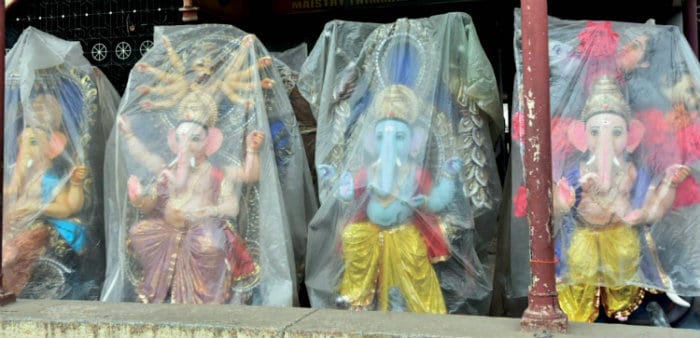
There are many families in Mysuru who are involved in making many household articles using clay such as pots, lamps (hanate), dolls, idols and other artefacts, in particular idols of Ganapati. Just before Ganesha Chaturthi, one can see colourful Ganesha idols on sale at every nook and corner of streets. When Team SOM spoke to a few families, who from generations are making idols of Lord Ganesha using clay, all of them complained against PoPs.
Leading a happier life
Jayanna (S. Jayashankar), who is 70-years-old, has been making idols of various Devis and Devatas at his shop on Basaveshwara Road from the last 12 years. He says he learnt this art form from his grandfather D. Puttaswamy and father Shivalingaiah 50 years ago.
“I even make Dasara idols and I have never used PoP. Most of the customers nowadays ask for clay Ganesha. I have a lot of regular customers who order for their idols in advance before the festival,” he adds.
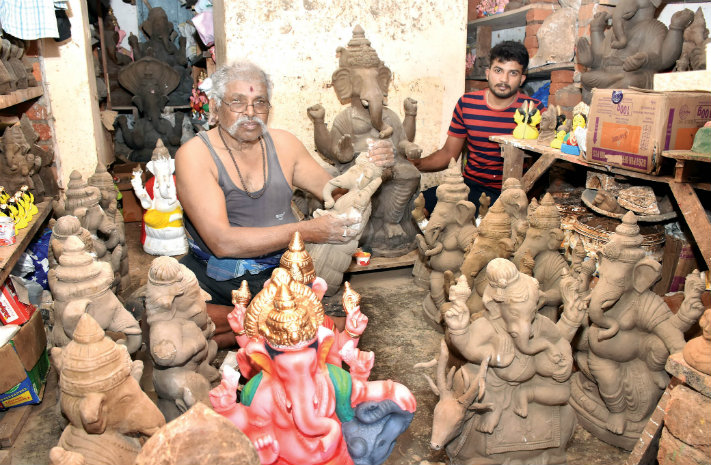
“After getting clay from Parasurayana Kere near Chamundi Hill which costs Rs. 2,000 per load and tempering the clay which costs Rs. 1,000, we mould different parts of the idol and later assemble them to give the final touch. I prefer making traditional idols, particularly different manifestations of the God-head like Hamsa Ganesha, Garuda Ganesha, Durbar Ganesha and so on,” he added.
His brother’s sons including Madhusudhan, Pradeep, Raghavendra, Puttaswamy and Mariappa are helping out Jayanna in this job. This time, Jayanna has crafted around 2,000 idols costing between Rs.25 and Rs. 7,500. “I have two daughters who are married and leading a happier life,” he added.
Great demand for eco-friendly Ganesha idols
One more idol-maker is N. Srinivasamurthy, a resident of Kumbarageri, who, along with his three sons, is making idols from the last 55 years after learning from his forefathers. His wife Shankaramma is also helping him since their marriage 30 years ago. They have two daughters who have been married to persons working in different professions who also help their parents during the festive season.
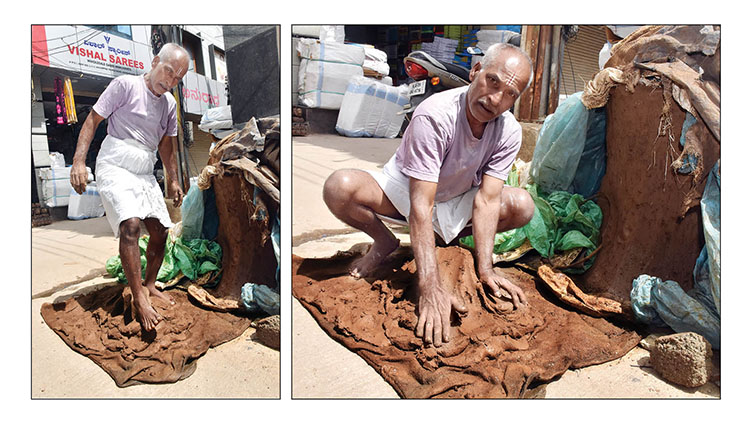
“Just like any other idol-makers, I used to make all kinds of idols, but from the last 2 to 3 years, I have been making only eco-friendly Ganesha as there is great demand,” Srinivasamurthy added.
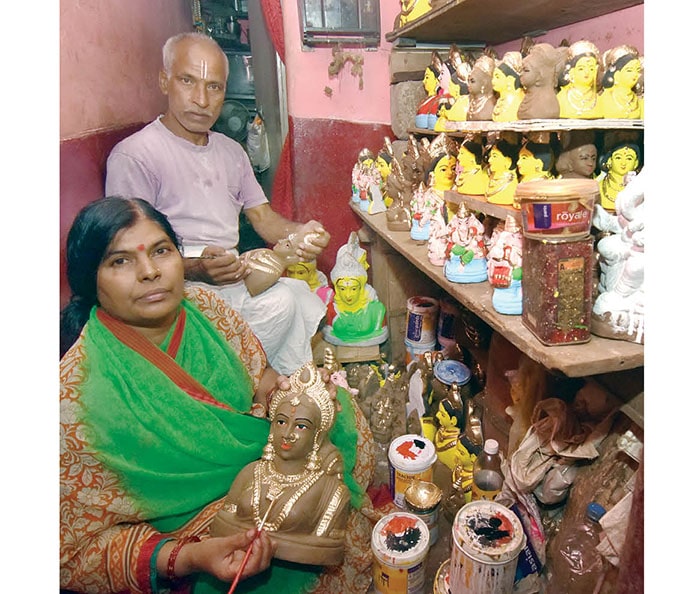
TEAM SOM
S.T. Ravikumar
M.T. Yogesh Kumar
M.B. Pavan Murthy and
M.N. Lakshminarayana Yadav



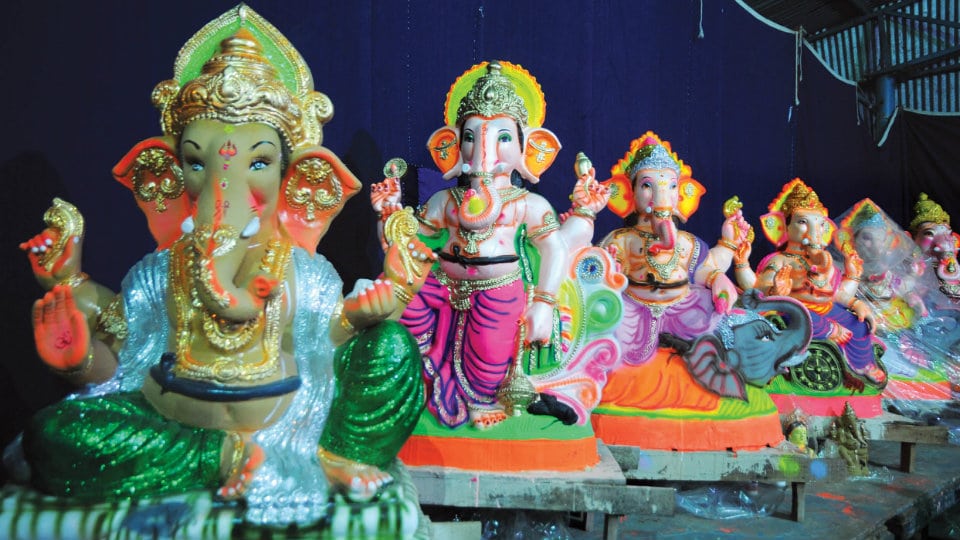




Recent Comments